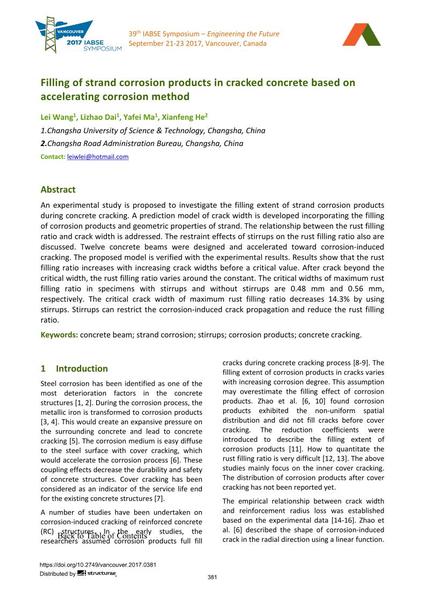Filling of strand corrosion products in cracked concrete based on accelerating corrosion method

|
|
|||||||||||
Bibliografische Angaben
| Autor(en): |
Lei Wang
(Changsha University of Science & Technology, Changsha, China)
Lizhao Dai (Changsha University of Science & Technology, Changsha, China) Yafei Ma (Changsha University of Science & Technology, Changsha, China) Xianfeng He (Changsha Road Administration Bureau, Changsha, China) |
||||
|---|---|---|---|---|---|
| Medium: | Tagungsbeitrag | ||||
| Sprache(n): | Englisch | ||||
| Tagung: | IABSE Symposium: Engineering the Future, Vancouver, Canada, 21-23 September 2017 | ||||
| Veröffentlicht in: | IABSE Symposium Vancouver 2017 | ||||
|
|||||
| Seite(n): | 381-388 | ||||
| Anzahl der Seiten (im PDF): | 8 | ||||
| Jahr: | 2017 | ||||
| DOI: | 10.2749/vancouver.2017.0381 | ||||
| Abstrakt: |
An experimental study is proposed to investigate the filling extent of strand corrosion products during concrete cracking. A prediction model of crack width is developed incorporating the filling of corrosion products and geometric properties of strand. The relationship between the rust filling ratio and crack width is addressed. The restraint effects of stirrups on the rust filling ratio also are discussed. Twelve concrete beams were designed and accelerated toward corrosion-induced cracking. The proposed model is verified with the experimental results. Results show that the rust filling ratio increases with increasing crack widths before a critical value. After crack beyond the critical width, the rust filling ratio varies around the constant. The critical widths of maximum rust filling ratio in specimens with stirrups and without stirrups are 0.48 mm and 0.56 mm, respectively. The critical crack width of maximum rust filling ratio decreases 14.3% by using stirrups. Stirrups can restrict the corrosion-induced crack propagation and reduce the rust filling ratio. |
||||
| Stichwörter: |
Korrosionsprodukte
|
||||
